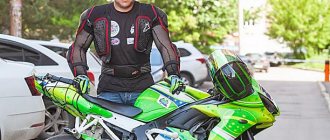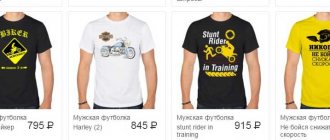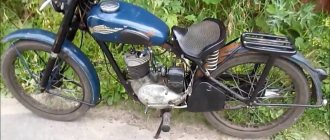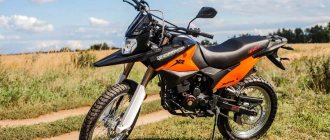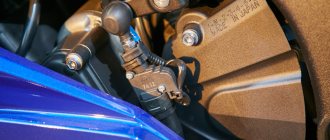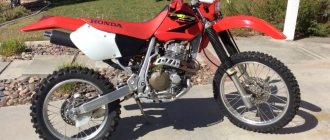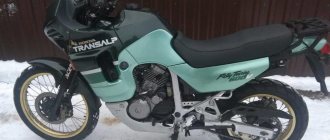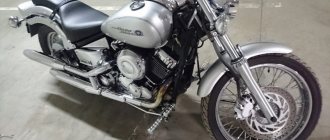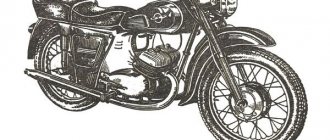The history of the use of motorcycles by police goes back more than a hundred years. The first police motorcycle was purchased for the needs of the New York Police Department back in 1907, and two-wheeled vehicles began to be used as official motorcycle patrol in California in 1911. Since then, motorcycle technology has repeatedly proven its advantages in the fight against crime in general and, as an option, is widely used for prompt response to road accidents.
In addition to efficiency, maneuverability and compactness are also undoubted advantages in the use of these two-wheeled vehicles by the police. And lower fuel consumption compared to cars will also allow you to save money. The only drawback of such patrols in Russia is the seasonality of their use. You can't ride a motorcycle in the cold. Although in countries with hot climates the possibility of using such technology remains all year round.
Popular brands of police motorcycles
Many motorcycle companies created special police cars that were very popular at the time, for example, Indian from the beginning of the 20th century to 1953 or Kawasaki from 1975 to 2005. But for various reasons, they could not withstand the competition in this niche and left the race. The most well-known brands of police motorcycles around the world today are BMW, Harley-Davidson, Honda and Yamaha. Road, tourist and sports varieties of motorbikes are used for police service.
Harley-Davidson
The motorcycle was first put at the disposal of the police in America and continues to serve them faithfully to this day. The company's history has had its ups and downs, but today, just like in the 1920s, 3,800 police departments in the United States ride Harley-Davidson on street patrol. In addition, the police of another 45 countries order motorcycles of this brand for road patrols and other needs. By comparison, in the 1980s, only 400 police departments in America rode Harley-Davidsons.
Today, the American manufacturer offers three modern models for police services: Harley-Davidson FLHTP Electra Glide, Harley-Davidson FLHP Road King and Harley-Davidson XL 883L Sportster. The first two bikes belong to the Touring line of models and are heavy cruisers designed for long trips, making them simply ideal for patrolling the streets. The XL 883L is more of a classic motorcycle than a cruiser, and can therefore be used for a variety of purposes.
The Electra Glide and Road King boast a six-speed transmission. For all three models, an anti-lock braking system (ABS) is available, the use of which increases driving safety.
BMW
BMW police motorcycles are perhaps the most popular in the world. The manufacturer claims that its motorcycle equipment for law enforcement agencies is supplied to 150 countries around the world and the total fleet of two-wheeled vehicles of the brand performing police functions has long exceeded 100,000 units. BMW Motorrad's products currently include the R1200RT-P and R900RT-P special police motorcycles. These motorbikes are lighter, have better handling, and the braking system is softer than that of Harley-Davidson.
The R1200RT-P is based on the standard 1170cc version. cm, however, with the addition of stainless steel safety bars. The R900RT-P has a smaller 878cc engine. cm and is not available in a civilian version.
Honda
The most widely popular police motorcycle is the Honda ST1300PA. Police forces in the UK and USA use motorbikes. Powerful, secretive, fast and reliable - this is how one of the best Japanese cruisers can be described. Japanese cars are more accessible and cheaper than their American counterparts and are equipped with standard police equipment. Japanese law enforcement officers also ride these same motorcycles.
Yamaha
The FJR1300 model is used to equip police motorcycle units in different countries. Following doubts about the safety of the Honda ST1300PA, which arose as a result of an accident with a British police officer, the British police began to purchase the Yamaha FJR1300. Police on motorcycles of this brand go on patrol in countries such as France, Belgium, the Netherlands, Australia, and Denmark.
A distinctive feature of the model is the diagonal aluminum frame. The 1.3-liter four-cylinder engine is equipped with a modern electronic D-Mode system for three power modes, has an adjustable YCC-T throttle and an exhaust control valve. The presence of a driveshaft instead of a chain drive and massive fairings also make the car stand out.
Police motorcycles in the Russian Federation
Motorcycles have been used by law enforcement agencies in the Russian Federation since Soviet times. In the 30–50s it was a Harley-Davidson 1200 with a sidecar; after the war it was replaced by the WLA 42 model of the same manufacturer. At the same time, the domestic army Ural M-72 was used, since the mid-60s it was replaced by the lighter and more maneuverable M-62, which was produced at the Irbit plant and was more suitable for police work.
At the end of the 60s, a small special series of Ural M-100 motorcycles with a sidecar and in a single version were developed for the Soviet law enforcement system. These were already real police bikes with special equipment installed on them. Production of this motorcycle for the police lasted from 1969 to 1994. The cars were produced in blue and yellow colors and were specially equipped with a siren, devices for installing traffic police devices, safety bars, and warning lights.
In the 70s, the police began to transfer to cars. The replacement of the motorized transport fleet primarily took place in large cities, but in remote regional departments it was possible to meet a district police officer on a motorcycle with a sidecar even in the 90s of the last century.
Currently, Russian police also use motorcycles. The first motorized police battalion (3rd specialized traffic police battalion) was created in Moscow. In 2011, it was equipped with BMW F 650 GS motorcycles, called “geese” by Russian bikers. In 2014, the fleet of this police unit was replenished with 60 brand new BMW R 1200 RT in a special police version.
Motorized vehicles in the Russian police are used in traffic police units for prompt arrival at the scene of a traffic accident in conditions of heavy congestion during rush hour in large cities, for patrolling in the warm season at night and in the evening to combat biker violators, for preventive working with motorcyclists.
Russian police motorcycles are painted white with additional blue stickers, equipped with a walkie-talkie, flashing lights, and an audible alarm. Increasingly, traffic police officers in large cities can be found riding specially equipped police motorcycles. To prevent, prevent and record offenses on the roads, mainly motorcycles from the German company BMW are purchased in a special police version of the R 1200 RT. The car has excellent handling. The boxer power unit creates good traction. Stability control system, active suspension adjustment, cruise control, gear shift assistant - this is not a complete list of the electronic systems of this motorcycle. The ride on it will be comfortable and confident on any road.
With a flashing light on its tail: the history of the Russian motorcycle police
Since its inception, the motorcycle has become one of the favorite instruments of the state, taking root not only in the army, but also on peaceful streets, as a police transport. We will tell you about them today, bringing together all the milestones in the history of the domestic two-wheeled police.
Unlike the army, where Harley-Davidson and Indian motorcycles served in pre-revolutionary Russia, motorcycles began to enter civilian service en masse only after the Great Patriotic War. Low motorization and the lag from the United States, where back in the 20s, cops chased sidecars of bootleggers in the same “sidecars” with flashing lights, and when arrested, they put them in a cage, also mounted on a motorcycle, began to be overcome only by the beginning of the “fifties.”
However, there were still rare two-wheeled exceptions. For example, before the war, NKVD units used PMZ-A-750 motorcycles, produced in the period from 1935 to 1939 at the Podolsk Mechanical Plant in the Moscow region, and they can be called the “first police”, as well as those purchased in the late twenties - early “ thirties" for traffic control and police departments BMW R11. So the modern choice of police officers, which we will talk about a little later, can be called historically fair.
One of the first photos of a police BMW dates back to 1933
After the Great Patriotic War, traffic on the streets began to pick up, and the number of still luxury cars and much more affordable motorcycles, which needed to be controlled, gradually grew. Various equipment were accepted for service at that time, but still, the main police motorcycle of those years was the M-72, although there were also quite a few IZH-49s.
In the photo there is an IZH-49 motorcycle with a front license plate mount that has become unnecessary, on which a plate is attached
In those days, they were just trying to systematize and bring to uniform standards the writing of numbers and letters on license plates, not to mention the requirements for the painting of motorcycles. Until 1953, a police motorcycle could be found in almost any color - order was restored only with an order from the Ministry of Internal Affairs, which standardized the color of police cars and motorcycles. It was then that the first color scheme appeared, which included a basic blue with red stripes.
A color combination of primary blue and additional red was introduced only at the end of 1953
The models in service at this time changed, but mostly they were Urals. The old ones were in no hurry to be written off, and new models arrived at law enforcement agencies chaotically, and each region remembered its own motorcycles: M-62, M-61, K-750 and other models that served well for decades.
At this time, motorcycles began to be modified specifically for police work, installing additional equipment such as walkie-talkies, flashing lights and sirens, as well as changing some parts. For example, some Urals were equipped with generators of increased power. Such motorcycles were assigned additional indices in the model name at the factories.
"Ural" in service in the State Traffic Inspectorate of the USSR
At the end of the sixties, the coloring of police cars and motorcycles changed again. According to rumors, the reason for changing the blue-red color scheme to yellow-blue was due to increased traffic on the roads and the need to increase visibility. It is this color scheme that will subsequently become the most famous and beloved by all restorers in the post-Soviet space.
The most famous paint scheme of a “police” motorcycle and the most popular police “Ural”
In addition to production motorcycles, prototypes also entered service. The most famous of these was the 1967 Ural M-100 motorcycle with a 1040 cc overhead valve engine and a huge fairing. Alas, the motorcycle, like many other IMZ developments, did not go into production, remaining a legend and a collector’s dream along with other prototypes.
Prototypes were tested by real service
A new era for two-wheeled police began in the seventies, because it was then that speed limits were introduced in Soviet traffic regulations. In addition, more and more fast motorcycles began to appear, which the heavy IMZ could not keep up with even without a sidecar. It is to combat such violators that a special motorized battalion is created in the capital’s traffic police, which later received the nickname “Motobat.”
“Urals” did not disappear from service and were actively exploited by traffic police officers, but against their background, motorized battalion employees were rightfully considered the elite. By the way, it was for them that brand new 900 cc BMW R90s were purchased in 1973-1975. It was this time that can be considered the beginning of the history of the modern motorized battalion.
By the mid-eighties, company cars, which had ceased to be a luxury, had practically replaced motorcycles from the traffic police fleet of large cities. However, the capital's motorized battalion still traveled mainly in foreign cars. As for other cities, there, as now, two-wheeled vehicles were bought on the principle of “who knows what.”
Motor scooter "Tula" in service, apparently, in the Tula traffic police
In 1990, the coloring of all traffic police cars was changed: instead of yellow, the main color became white, combined with blue elements and inscriptions, and in 1998, the traffic police was renamed the traffic police, and although more than a quarter of a century has passed, the name traffic police is in no hurry to go out of use. At that time, against the backdrop of a deep economic crisis, employees switched to domestic motorcycles, which became the IZH “Jupiter 5” and “Ural”, and later, in the early 2000s, the “Junker”, while the motorized battalion remained true to itself and traditions when choosing BMW equipment. At various times, their motorcycle fleet included the BMW R1100GS, BMW R1150R, BMW R850R and others.
One of the last police "Urals" with liquid cooling and additional equipment
The gap between the German and domestic motorcycle industry only grew, so IZhi and Urals were written off in the capital by the end of the 2000s, and until recently these motorcycles could only be found in the regions. The capital's traffic police departments, following the motorized battalion, began to purchase German equipment: BMW G650GS, BMW F650GS, BMW F800ST and other models.
A typical metropolitan (and not only) policeman on a motorcycle looks something like this
There are also Japanese motorcycles Yamaha FZ6S in the service of the capital's traffic police. And the motobat traditionally chooses more powerful motorcycles - at different times in its fleet there were BMW K1200GT and BMW F800GS, but still the main and most beloved device is the previous generation BMW R1200RT, which today is gradually replacing the new one.
The most popular and beloved by the capital's motorcycle battalion is the previous generation BMW R1200RT police motorcycle.
They also buy German motorcycles in other large cities, but, having freedom of choice, other regions often prefer cheaper equipment. For example, in Nizhny Novgorod the traffic police use several 125 cc Yamaha Cyngus scooters, in the Tula region they ride the latest generation Honda Transalp, and in Voronezh they ride the Yamaha FZ family. There are also fragments of the past, such as “Urals”, and not simple ones, but with liquid cooling, which until recently worked in Chelyabinsk, as well as “Junkers”, which could be found in Krasnodar a few years ago.
In Kuzbass, for example, there is a pair of KTM 1290 Adventure, and in Nizhny Novgorod - Yamaha Cyngus
As you can see, the motorcycle in the service of domestic police officers will celebrate its centenary any day now, and against the backdrop of the development of motorcycle culture and the increase in the number of motorcyclists on the roads, clearly no one is going to send “two-wheeled patrolmen” to retirement, as well as part with foreign cars. Traditions, you know, are more important than all these import substitutions of yours!
Subscribe to Omoimot magazine updates on VKontakte, Facebook, Twitter or Google+ to learn about the most interesting things from the world of motorcycles.
Photos in the article belong to their authors
What will the police motorcycle look like in the future?
And in conclusion, a few words about the direction of development of two-wheeled motorcycle transport for police services. The Zero MMX electric motorcycle was created for military purposes, but the advantages of this prototype can also be used for police purposes. The main quality of such a machine is noiselessness. Its environmental friendliness is also not in last place here, because it is public services that must set an example of caring for the environment. Simplicity of design and ease of repair will also be obvious advantages. The motorcycle does not need to be charged; the batteries are easily replaced.
Electric motorcycles are already being tested by the Los Angeles Police Department and are showing good results in their use. What do you think about this direction of development of police motorbikes, such as electrification? Will electric drives be able to completely replace internal combustion engines in police motorcycles?
Myth fifth. Internal instructions of the Ministry of Internal Affairs prohibit the pursuit of motorcycles, mopeds and scooters.
This is the most persistent myth. Seeing that traffic police officers turn a blind eye to motorcyclists, many come to the conclusion that traffic police officers are prohibited from stopping motorcyclists by some internal instruction. After all, if she hadn’t been there, they would have definitely chased the motorcyclist.
All this is nothing more than a myth; there are no instructions that would limit the desire of a traffic police officer to chase a motorcycle. After all, think for yourself, it makes sense to give motorcyclists some special privileges, even if informally. All the same, traffic police officers will tell their friends about this instruction, and they, in turn, will convey this information to motorcyclists, and they will ride on the roads with impunity, knowing full well that no one will chase them.
